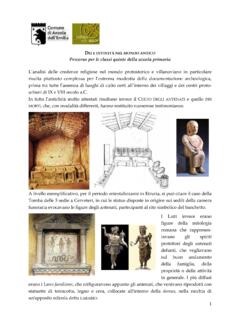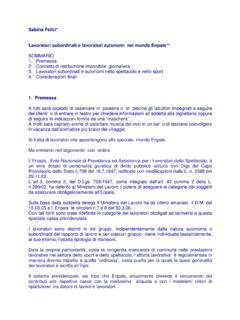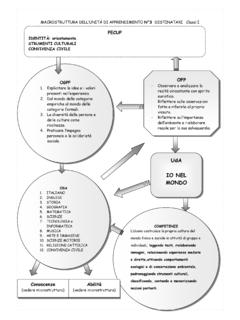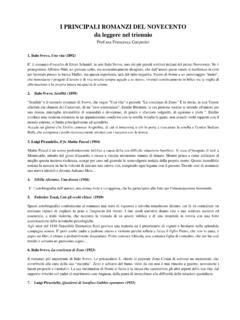Transcription of Background Paper 6.21 Hearing Loss - WHO
1 Priority Medicines for Europe and the World "A Public Health Approach to Innovation" Update on 2004 Background Paper Background Paper Hearing loss By B atrice Duthey, 20 February 2013 Update on 2004 Background Paper , BP Hearing loss Table of Contents Executive Summary .. 4 1. Introduction .. 5 Hearing loss definitions .. 5 Possible Causes of Hearing loss .. 7 Ear 7 Untreated infections during childhood .. 8 Congenital Hearing loss .. 8 Injury/trauma .. 9 Aging .. 9 Exposure to prolonged or excessive noise .. 9 Medications and other chemicals that are toxic to the ear .. 9 Nutritional Deficiency Causes .. 10 Diagnosis .. 11 New borns and Infants Diagnosis.
2 11 Children and Adult Diagnosis .. 11 2. What are the Epidemiological Trends for Europe and the World? .. 11 General .. 11 Prevalence .. 12 Prevalence in the world .. 12 Prevalence in Europe .. 15 3. What is the control Strategy? .. 17 Prevention Measures .. 17 Primordial Prevention .. 17 Secondary Prevention .. 18 Tertiary prevention .. 18 Therapies .. 19 4. What is known of the Availability, Feasibility and Sustainability of the Control Strategy? .. 20 The European Burden of Hearing loss and cost .. 20 Feasibility and Control Strategy .. 21 5. Why does the Disease Burden Persist? .. 22 Lack of awareness of the problem .. 22 Poor Diagnosis .. 23 A lack of epidemiological data.
3 23 Poor living conditions and lack of vaccination coverage .. 23 Underuse of Hearing devices .. 23 Exposure to noise .. 24 Aging of the population .. 24 Update on 2004 Background Paper , BP Hearing loss Gaps of research into pharmacological interventions .. 24 6. Past/Current Research into Pharmaceutical Interventions for this Condition .. 25 Antioxidants and ROS scavengers .. 25 Sodium thiosulfate (STS) .. 25 Alpha Lipoic Acid .. 26 N-acetylcysteine .. 27 Ginkgo Biloba .. 27 Dietary supplements: Vitamins and minerals .. 27 Anti-inflammatory agents .. 28 Salicylate/Aspirin .. 28 Steroids .. 28 TNF- inhibitors .. 29 Anti-apoptotic agents .. 30 New Promising drug candidates from animal studies.
4 30 RNA interference .. 30 Nanotechnology for drug administration to the cochlea .. 31 D-methionine .. 31 Resveratrol .. 31 Neurotrophic factors .. 31 Caspase Inhibitors .. 31 Stem cell transplantation .. 32 Targeted Neural Stimulation .. 32 7. What is the Current Pipeline of Products that Are to Be Used for this Particular Condition? .. 33 Extended Wear Hearing Aids .. 33 Cochlear Implants .. 34 Middle Ear Implants .. 35 Sign Language .. 35 8. What is the Current Status of Institutions and Human Resources Available to Address the ear disease and Hearing impairment and disability? .. 35 Public Fundings .. 35 European Sources of Funding .. 35 Initiatives from the World Health Organization (WHO).
5 36 Private Fundings .. 36 9. Gaps between current research and potential research issues which could make a difference 37 10. Conclusion .. 38 References .. 38 Annexes .. 45 Annex : Countries and territories in analysis regions.. 45 Annex : DALYs caused by Hearing loss , by age group, regions and sex* .. 46 Annex : Cochrane study summary on medical interventions .. 48 Update on 2004 Background Paper , BP Hearing loss Executive Summary The World Health Organization (WHO) estimated in 2008 that over 360 million persons have disabling Hearing loss which represents of the world population. Eighty per cent of these people reside in low- or middle-income countries (LMIC). In Europe, about 52 million people are affected and more than 50% of European adults beyond 65 years old present slight to severe Hearing loss according 2010 estimates.
6 Epidemiological surveys are scarce and particularly in low-income countries as a result of difficulty field testing of Hearing levels, poor diagnosis and reporting as well as lack of awareness of the problem leading to shortage of funding to conduct surveys. With the aging of the world population these numbers are expected to rise substantially. Hearing loss is an important public health concern with substantial economic and societal costs. In infants and children Hearing impairment retards developmental language and educational progress. In adults, it causes difficulties in both professional and social life as well as stigmatization. Apart from consequences to the individual person, Hearing loss also leads to high costs to society.
7 Hearing impairment can be caused by a number of factors including infections during childhood such as measles, mumps and meningitis, chronic otitis media, exposure to excessive or prolonged noise, head/neck injuries, use of ototoxic medications such as certain types of chemotherapies and antibiotics, industrial solvents, congenital abnormalities and infections and perinatal problems, certain nutritional deficiencies, genetic disorders and aging. Use of Hearing devices such as aids and cochlear implants as well as sign language, lip reading and special amplification systems in schools are strategies to help affected people manage their communication.
8 Although the prevalence of Hearing impairment is high, very little research towards pharmaceutical treatment has been made in the previous decades. Within the past few years, exciting research on genetic manipulation, gene therapy, and stem cell transplantation as well pharmaceutical agents, suggest that a therapeutic treatment for Hearing loss may eventually be possible in the future. Update on 2004 Background Paper , BP Hearing loss 1. Introduction In 2004, Warren Kaplan and Richard Laing wrote the Priority Medicines for Europe and the World Report. This report did not address Hearing loss , but by 2012 the burden of disease caused by Hearing loss justified an in-depth study.
9 The ability to hear is critical to understanding the world around us as well as interacting with each other. Hearing impairment is the most frequent sensory deficit in human populations and affects newborns, children, adults and In children, Hearing loss can be inherited, or acquired as sequalae of viral or bacterial infections during pregnancy, childhood or complications during birth, also due to ototoxic drugs, excessive noise and specific nutritional deficiencies. In adults, the major causes of Hearing loss are presbycusis which is related to ageing, excessive and prolonged exposure to noise, acoustic and physical trauma, and use of ototoxic drugs such as certain types of chemotherapies, antibiotics, and industrial chemicals.
10 This Background report reviews global data on Hearing loss among children and adults in Europe and the world and provides estimates on disability prevalence and costs of management. In addition this report reviews scientific progress and identifies gaps and opportunities for research interventions towards prevention or cure. There has been exciting research performed recently on a possible preventive treatment of Hearing loss caused by ototoxic medications or high level of noise. Following the success of research from animal experiments, several promising clinical trials have been launched. These trials offer exciting possibilities not only for prevention of Hearing loss but also for a possible treatment to restore auditory functions.

















